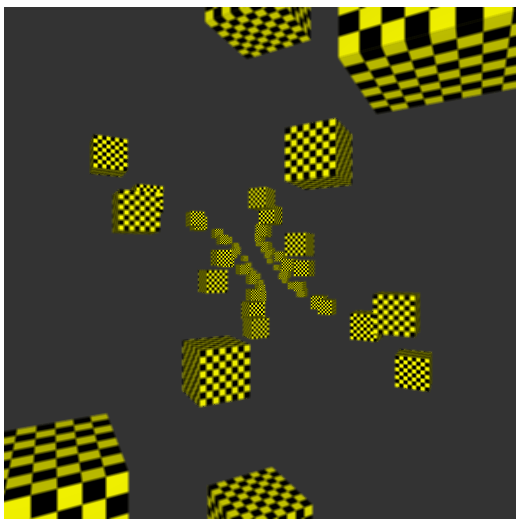
The DOF demo with range 150 (about half way into the cube field).
I talked about doing some depth-of-field focus demos recently. It's a very popular camera focus effect that basically blurs stuff out increasingly as it's farther away from some point of interest. The basic version renders the depth map out, and then a post-processing shader reads this, and uses the depth value to decide how much blur to apply. I did a WebGL depth-of-field demo of this yesterday. You can dial in a depth value to use as the "in-focus" range from the camera. The shader splits depths either side of this into a "far" and "very far" range. The far range has a 3x3 linear blur kernel applied. The very far range has a 5x5 kernel of blur. It seems to work quite well.

First problem - WebGL doesn't have writing to depth textures as standard. You can either do the old, clunky, horrible, way of manually writing out an to attached texture and re-arranging the bits to whatever format, or you can enable the depth texture extension, which I did.
You can find a list of all of the extensions for WebGL at the WebGL Extension Registry. The way to use an extension is to first test if it exists in the user's browser. I do this right after getting the GL context for the canvas:
Where name is the string as listed on the Registry, i.e. "WEBGL_depth_texture". Confusingly, sometimes all you need to do is check if the extension exists, and other times, you need to retain the extension returned to use as an interface. You need to do this for VAO, anisotropy, and sRGB extensions. I keep these as globals alongside my var gl;. I tried all the extensions on the registry, and printed into a paragraph on my web page if they weren't supported. Most of them were in my work machine's Chrome and FireFox.
Depth textures are worth using, and well supported. Vertex Array Objects (VAO) can significantly tidy up your drawing code, reduce some JavaScript and general overhead, and are also well supported. You have to use the extension as the interface though, so vao_ext.createVertexArrayOES() - you can't just use the main gl. interface. sRGB colour spaces report good support but actually are kind of broken - I get different bugs and functionality in my Chrome and FireFox, so I'll just do gamma correction the old-fashioned way. Anisotropic filtering for textures has always been an extension for desktop OpenGL too, despite being around since forever, because of some childish copyright nonsense by one of the larger graphics corporations. Worth using to make your textures look nice at angles to the camera - use factor 4.0, the built-in maximum constant appears to be buggy.
One of the limitations of WebGL is that you tend to be forced to work in a small canvas area or viewport. You only have so many pixels to work with then, so any 3d rendering of scenes can start to look pretty bad, despite reasonably good multi-sample anti-aliasing (MSAA) being built into most browsers. One trick here, which I did in my DOF demo there, is to use super-sample anti-aliasing (SSAA), which, in the simplest case, just means rendering to a framebuffer texture and viewport 2x larger than the canvas area, and sampling that later in a normal-sized viewport. If you enable bi-linear filtering on the framebuffer textures you can get some quite sharp-looking images on small display areas via smoke and mirrors and extra processing time.
It sounds like a Dungeons and Dragons spell, but it's just a more advanced focus blur effect to try next. The limitation of DOF is that your focus is in one dimension (depth), but perhaps you want a mouse cursor to select an arbitrary thing to focus on, and all 3d distances (not just depth) from that to be blurred. I think it should be possible to just use a combination of 2d screen-space position and depth, without needing to store the 3d positions in a buffer.
Basically, with a focus-blur effect, you want stuff in the foreground to be blurred, mid-ground to be in focus, surroundings a little blurred, and background to be very blurred. Because we have more pixels for things rendered close to the camera they look less blurry with the same filter than far-away things. Perhaps a better effect would have a very large blur for the foreground - even rendering to a smaller texture or mip-mapped texture with a higher level beforehand might be wise. Then perhaps a medium blur and large blur for the far background. Non-linear blur selection, in other words.